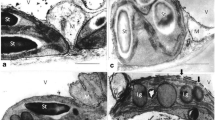Abstract
Changes in the level of the endoplasmicreticulum (ER) marker enzyme cytochrome-c reductase (EC 1.6.2.1) were followed with time of imbibition of de-embryonated half-seeds of barley (Hordeum vulgare L.) and the subsequent incubation of their aleurone layers in gibberellic acid (GA3) and H2O. During imbibition there is an increase in the level of cytochrome-c-reductase activity and in the amount of 280-nm absorbance associated with this enzyme. When aleurone layers are incubated for a further 42 h in water, there is a doubling of the cytochrome-c-reductase activity. In GA3, the activity of cytochrome-c reductase reaches a maximum at 24 h of incubation and thereafter falls to below 70% of its level at the beginning of the incubation period. Changes in the cytochrome-c-reductase activity correlate with changes in the fine structure of the aleurone cell. The ER isolated in low Mg2+ from aleurone layers incubated in buffer for up to 18 h has buoyant density of 1.13–1.14 g cc-1 while that from layers incubated in GA3 for 7.5–18 h has a density of 1.11–1.12 g cc-1. The α-amylase (EC3.2.1.1) isolated with the organelle fraction by Sepharose gel filtration is associated with the ER on isopycnic and rate-zonal density gradients, and its activity can be enhanced by Triton X-100. The soluble α-amylase fraction from Separose-4B columns, on the other hand, is not Triton-activated but is acid-labile. Acid phosphatase (EC3.1.3.2) is distributed in at least three peaks on isopycnic gradients. In low Mg2+ the second peak of activity has a density of 1.12 g cc-1 in GA3-treated tissue and 1.13–1.14 g cc-1 in H2O-treated tissue. With high-Mg2+ buffers, this peak of phosphatase activity disappears. Acid-phosphatase activity is not enhanced by Triton X-100 nor is it acid-labile.
Similar content being viewed by others
Abbreviations
- EDTA:
-
ethylenediaminetetraacetic acid
- ER:
-
endoplasmic reticulum
- GA:
-
gibberellin
- GA3 :
-
gibberellic acid
References
Anderson, L.E., McClure, W.O. (1973) An improved scintillation cocktail of high solubilizing power. Anal. Biochem. 51, 173–179
Chlapowski, F.J., Bond, R.N. (1971) Assembly of lipids into membranes of Acanthamoeba palestinensis. J. Cell. Biol. 50, 625–633
Chrispeels, M.J., Varner, J.E. (1967) Gibberellic acid-enhanced synthesis and release of α-amylase and ribonuclease by isolated barley aleurone layers. Plant Physiol. 42, 398–406
Colborne, A.J., Morris, G., Laidman, D.L. (1976) The formation of endoplasmic reticulum in aleurone cells of germinating wheat: an ultrastructural study. J. Exp. Bot. 27, 759–768
Evins, W.H., Varner, J.E. (1971) Hormone controlled synthesis of endoplasmic reticulum in barley aleurone cells. Proc. Nat. Acad. Sci. USA 68, 1631–1633
Firn, R.D. (1975) On the secretion of α-amylase of barley aleurone layers after incubation in gibberellic acid. Planta 125, 227–233
Firn, R.D., Kende, H. (1974) Some effects of applied gibberellic acid on the synthesis and degradation of lipids in isolated barley aleurone layers. Plant Physiol. 54, 911–915
Gibson, R.A., Paleg, L.G. (1976) Purification of GA3-induced lysosomes from wheat aleurone cells. J. Cell Sci. 22, 413–425
Ho, D.T., Varner, J.E. (1974) Hormonal control of messenger ribonucleic acid metabolism in barley aleurone layers. Proc. Nat. Acad. Sci. USA 71, 4783–4786
Jones, R.L. (1969a) Gibberellic acid and the fine structure of barley aleurone cells. I. Changes during the lag phase of α-amylase synthesis. Planta 87, 119–133
Jones, R.L. (1969b) Gibberellic acid and the fine structure of barley aleurone cells. II. Changes during the synthesis and secretion of α-amylase. Planta 88, 73–86
Jones, R.L. (1972) Fractionation of the enzymes of the barley aleurone layer: evidence for a soluble mode of release Planta 103, 95–109
Jones, R.L. (1980) The isolation of endoplasmic reticulum from barley aleurone layers. Planta 150, 58–69
Jones, R.L., Jacobsen, J.V. (1978) Membrane and RNA metabolism in the response of aleurone cells to GA. Bot. Mag. Tokyo, Spec. Issue 1, 83–99
Jones, R.L., Price, J.M. (1970) Gibberellic acid and the fine structure of barley aleurone cells. III. Vacuolation of the aleurone cell during the phase of ribonuclease release. Planta 94, 191–202
Jones, R.L., Varner, J.E. (1967) The bioassay of gibberellins. Planta 72, 155–161
Kagawa, T., Lord, J.M., Beevers, H. (1973) The origin and turnover of organelle membranes in castor bean endosperm. Plant Physiol. 51, 61–65
Locy, R., Kende, H. (1978) The mode of secretion of α-amylase in barley aleurone layers. Planta 143, 89–99
Obata, T., Suzuki, H. (1976) Gibberellic acid-induced secretion of hydrolases in barley aleurone layers. Plant Cell Physiol. 17, 63–71
Paleg, L.G., Hyde, B. (1964) Physiological effects of gibberellic acid. VII. Electron microscopy of barley aleurone cells. Plant Physiol. 39, 673–680
Ray, P.M., Shininger, T.L., Ray, M.M. (1969) Isolation of β-glucan synthetase particles from plant cells and identification with golgi membranes. Proc. Nat. Acad. Sci. USA 64, 605–612
Slaby, F., Brown, C. (1974) Changes in the ribosome content, principal microsomal protein composition, and secretory character of mammary epithelial rough endoplasmic reticulum during differentiation. J. Cell Biol. 61, 613–632
Varner, J.E., Mense, R. (1972) Characteristics of the process of enzyme release from secretory plant cells. Plant Physiol. 49, 187–189
Varty, K., Laidman, D.L. (1976) The pattern and control of phospholipid metabolism in wheat aleurone tissue. J. Exp. Bot. 27, 748–758
Vigil, E.L., Ruddat, M. (1973) Effect of gibberellic acid and actinomycin D on the formation and distribution of rough endoplasmic reticulum in barley aleurone cells. Plant Physiol. 51, 549–558
Wickner, W. (1979) The assembly of proteins into biological membranes: the membrane trigger hypothesis. Ann. Rev. Biochem. 48, 23–45
Author information
Authors and Affiliations
Rights and permissions
About this article
Cite this article
Jones, R.L. Quantitative and qualitative changes in the endoplasmic reticulum of barley aleurone layers. Planta 150, 70–81 (1980). https://doi.org/10.1007/BF00385617
Received:
Accepted:
Issue Date:
DOI: https://doi.org/10.1007/BF00385617




